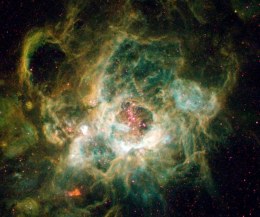Carbon nanotubes form in space but use a metal-free chemistry until now unavailable to chemists on Earth. The discovery is a surprising outcome of laboratory experiments designed by Joseph Nuth at NASA’s Goddard Space Flight Center, in Greenbelt, Maryland, and his colleagues. They were hoping to understand how carbon atoms are recycled in stellar nurseries, the regions of space where stars and planets are born, but the finding could have applications in nanotechnology, as well as help explain some characteristics of supernovae.
Writing in the journal Astrophys J Lett, Nuth and colleagues explain how astrochemistry makes carbon nanotubes without requiring a metal catalyst. Nanotubes are produced, they say, when graphite dust particles are exposed to a mixture of carbon monoxide and hydrogen gases, conditions that exist in interstellar space.
The finding corroborates the discovery of graphite whiskers, bigger than nano nanotubes, in three meteorites. The meteoric discovery hinted at why some supernovae appear dimmer and farther away than they ought to be based on calculations using current models. Nuth’s approach is a variation of a well-established way to produce gasoline or other liquid fuels from coal. It’s known as Fischer-Tropsch synthesis, and researchers suspect that it could have produced at least some of the simple carbon-based compounds in the early solar system. Nuth proposes that the nanotubes yielded by such reactions could be the key to the recycling of the carbon that gets released when carbon-rich grains are destroyed by supernova explosions.

The structure of the carbon nanotubes produced by Nuth and colleagues was determined by materials scientist Yuki Kimura, of Tohoku University, Japan, using transmission electron microscopy. He observed particles on which the original smooth graphite gradually morphed into an unstructured region and finally to an area rich in tangled hair-like masses. A closer look with an even more powerful microscope showed that these tendrils were in fact cup-stacked carbon nanotubes, resembling a stack of disposable drinking cups with the bottoms removed. If further testing indicates that the new method is suitable for materials-science applications, it could supplement, or even replace, the familiar way of making nanotubes, explains Kimura.
Researchers might also now evaluate whether graphite whiskers absorb light. A positive result would lend credence to the proposition that the presence of these molecules in space affects the observations of some supernovae.
LINKS
Astrophys J Lett, 2010, 710, L98-L101
http://dx.doi.org/10.1088/2041-8205/710/1/L98